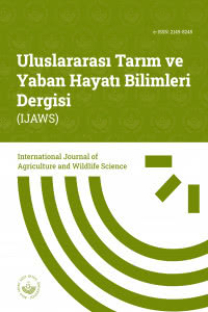Türkiye'nin güneyindeki Hatay'dan Gerbillus dasyurus (Rodentia: Gerbillinae) Kaydı
Gerbillus dasyurus (Rodentia: Gerbillinae) Record from Hatay Province, in the South of Turkey
Wagner’s gerbil, distribution, karyotype, phallus, baculum, abundance.,
___
- Abu-Baker, M. A., & Amr, Z. (2003). A morphometric and taxonomic revision of the genus Gerbillus (Mammalia, Rodentia, Gerbillidae) in Jordan with notes on its current distribution. Zoologische Abhandlungen, 53, 177-204.
- Amori, G., Hutterer, R., Kryštufek, B., Yigit, N., Mitsainas, G., Palomo, L., & Aulagnier, S. (2021). Gerbillus dasyurus (amended version of 2016 assessment). The IUCN Red List of Threatened Species 2021: e.T9116A197509063. https://dx.doi.org/10.2305/IUCN.UK.2021-1.RLTS.T9116A197509063.en.
- Burgin, C. J., Wilson D. E., Mittermeier, R. A., Rylands, A. B., Lacher, T. E., & Sechrest, W. (2020). Illustrated Checklist of the Mammals of the World. Volume 1. Monotremata to Rodentia. Lynx Editions, Barcelona.
- Çoğal, M., Ünal, M., Öktem, İ. M. A., & Sözen, M. (2016). A Preliminary Study to Determine Distribution and Ecology of Striped Hyaena (Hyaena hyaena) in the Area between Hassa and Reyhanli (Hatay). Nature and Man, 50, 24-37.
- Çolak, E., Sözen, M., & Yiğit, N. (1999). Observations on the Reproductive Biology of Gerbillus dasyurus (Wagner, 1842) (Mammalia: Rodentia) in Turkey. Turkish Journal of Zoology, 23, 243-246.
- Corbet, G. B. (1978). The Mammals of the Palaearctic Region: A Taxonomic Review. Vol. 2. London and Ithaca, British Museum (Natural History) and Cornell University Press, United Kingdom.
- Haim, A., & Tchemov, E. (1974). The distribution of myomorph rodents in the Sinai Peninsula. Mammalia, 38, 201-223.
- Harrison, D. L., & Bates, P. J. J. (1991). The Mammals of Arabia. Vol. 25. Harrison Zoological Museum. Kent, United Kingdom.
- Karataş, A. (2016). Mammalian (Mammalia) of Hatay Province. Nature and Man, 50, 17-23.
- Kryštufek, B., & Vohralík, V. (2001). Mammals of Turkey and Cyprus. Introduction, Checklist, Insectivora. Vol. 1. Slovenia, Koper.
- Kryštufek, B., & Vohralík, V. (2009). Mammals of Turkey and Cyprus. Rodentia II: Cricetinae, Muridae, Spalacidae, Calomyscidae, Capromyidae, Hystricidae, Castoridae. Slovenia, Koper.
- Lay, D. M., & Nadler, C. F. (1975). A study of Gerbillus (Rodentia: Gerbillinae) east of Euphrates River. Mammalia, 39(3), 423-445.
- Qumsiyeh, M. B., Schlitter, D., & Disi, A. (1986). New records and karyotypes of mammals from Jordan. Mammalian Biology, 51, 139–146.
- Scott, D. M., & Dunstone, N. (2000). Environmental determinants of the composition of desert-living rodent communities in the north-east Badia region of Jordan. Zoological Society of London, 251, 481-494. https://doi.org/10.1111/j.1469-7998.2000.tb00804.x
- Shenbrot, G. I., Krasnov, B. R., & Khokhlova, I. S. (1997). Biology of Wagner's gerbil Gerbillus dasyurus (Wagner, 1842) (Rodentia: Gerbillinae) in the Negev Highlands, Israel. Mammalia, 61, 467- 486.
- Sözen, M. (2021). Mammal Diversity of Hatay Province and Conservation Suggestions. Doğanın Sesi, 4, 40-53.
- Tel, M., Temizer, A., Öner, A., Karacan, H., & Veldet, E. (2016). Kilis İli Kayalık Gerbili (Gerbillus dasyurus) Tür Eylem Planı 2016 – 2020. Aktel Mühendislik, Ankara.
- Wahrman, J., & Zahavi, A. (1955). Cytological contributions to the phylogeny and Classification of the rodent genus Gerbillus. Nature, 175, 600-602.
- Wassif, K., Lutfy, R. G., & Wassif, S. (1969). Morphological cytological and taxonomical studies of the rodent genera Gerbillus and Dipodillus from Egypt. Proceedings of the Egyptian Academy of Sciences, 22, 77-97.
- Wilson, D. E., & Reeder, D. M. (2005). Mammal Species of the World. A Taxonomic and Geographic Reference. Vol. 3. John Hopkins Univ. Press, Baltimore, United States.
- Wilson, D. E., Lacher, T. E., & Mittermeier, R. A. (2017). Handbook of the Mammals of the World. Vol. 7. Rodents II. Lynx Edicions. Barcelona.
- Yiğit, N., Çolak, E., Sözen, M., & Karataş, A. (2006). Rodents of Turkey. Vol. 1. Ankara, Turkey, Meteksan Company.
- Yiğit, N., Çolak, E., Sözen, M., & Özkurt, Ş. (2003). A study on geographical distribution along with habitat aspects of rodent species in Turkey. Bonner Zoologische Beiträge, 50, 355-368.
- Yiğit, N., Kıvanç, E., Çolak, E., & Sözen, M. (1997). Gerbil record from Turkey: Gerbillus (Hendecapleura) dasyurus (Wagner, 1842) (Rodentia: Gerbillinae). Israel Journal of Zoology, 43, 13-18.
- Zahavi, A., & Wahrman, J. (1957). The cytotaxonomy, ecology and evolution of the gerbils and jirds of Israel (Rodentia: Gerbillinae). Mammalia, 21, 341-380.
- ISSN: 2149-8245
- Başlangıç: 2015
- Yayıncı: BOLU ABANT İZZET BAYSAL ÜNİVERSİTESİ > ZİRAAT VE DOĞA BİLİMLERİ FAKÜLTESİ
Sulu Tarım Arazilerinde Kapitalizasyon Faiz Oranının Saptanması: Tokat İli Kazova Bölgesi Örneği
Nurgül KARADOĞAN, Bilge GÖZENER
Tarhan Köyü Merası Kiralama Talebinin Mera Kanunu Açısından Değerlendirilmesi
Hörünaz ERDOĞAN, Muhammet ŞAHİN, Ömer Faruk UZUN
Neslihan KILIÇ, Hayriye Yıldız DAŞGAN, Boran İKİZ
Tuba BAK, Emrah GÜLER, Turan KARADENİZ, Furkan Burak OKTAY
Türkiye'nin güneyindeki Hatay'dan Gerbillus dasyurus (Rodentia: Gerbillinae) Kaydı
Hacer Handan ALTINOK, Canan CAN, Özge DEMİREL, Gamze YÜKSEL
Bolu Yöresi Bal Arılarında (Apis mellifera L., 1758) Nosemosis ve Varroosis'in Yaygınlığı
Mehmet KİREMİT, Hussein Mohamed OSMAN, Hakan ARSLAN
Bazı Elazığ Biberi (Capsicum annuuum L.) Genotiplerinin Morfolojik Karakterizasyonu
